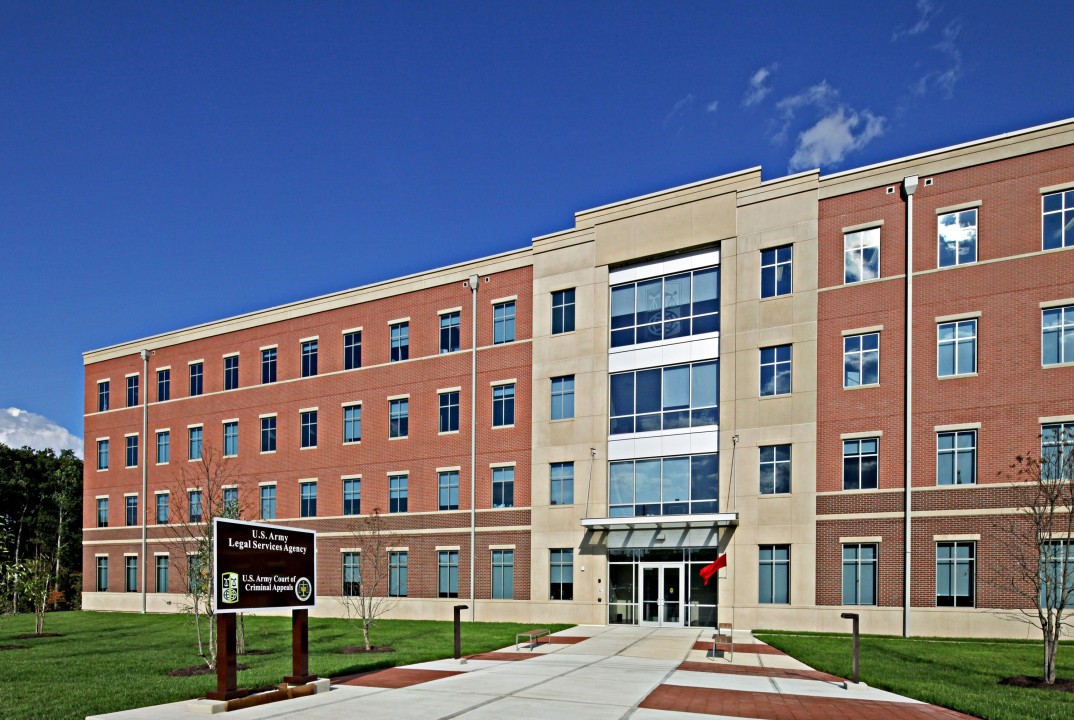
How we see around corners on federal design-build projects
Suffolk’s upfront project planning combines innovative technologies and processes to save time, cut costs and drive predictability for our government clients.
Back in 2012, Suffolk successfully delivered the award-winning BRAC 132 USALSA Army Administrative Facility in Fort Belvoir, Va. This design-build project was a multi-story Command Headquarters Building with a separate elevated parking garage. The building consisted of about 97,000 square feet of administrative space, emergency operations center, appellate courtroom and adjoining spaces, and secure conference rooms. The facility now serves as the new home for Army personnel relocating to Fort Belvoir and won AGC Metro Washington’s Best Lean Construction Project award.
Over the last decade, we’ve focused more on sectors outside of the federal government. But that experience — along with lessons learned on the BRAC project — has helped us develop new processes and strengthen our capabilities for our government partners. We’re now jumping back into federal work with a supercharged approach that drives predictability in cost and schedule delivery without sacrificing quality.
Using our multi-faceted project planning strategy relies on the following core components.
Digital Engineering: Our dedicated Digital Engineering team, led by National Director Alexis McGuffin, works with a wide range of tools like reality capture, artificial intelligence, data analytics, BIM and digital twins. By leveraging these solutions, they can improve efficiency, quality, and sustainability on our projects.
Suffolk Design: Federal design-build projects can be complex undertakings, requiring a cohesive, high-functioning team of experts all moving in sync to deliver exceptional outcomes. That team needs to pay close attention to project details and requirements — like scope, quality, budget and schedule — to spot any gaps in meeting client objectives. The best design-build teams collaborate and communicate efficiently, and they’re drawn together by the challenge before them. This is where Suffolk Design, our in-house design management team, steps in to ensure our clients get the very most out of the design-build team. Led by Senior Vice President Chris Lanzisera, AIA, Suffolk Design is staffed by experienced design professionals who focus on bringing our design and construction teams together in a comprehensive and rigorous design-build process. We’ve found that when we follow our design-build playbook, we can successfully deliver any project.
We used a similar approach for our project at the VA Outpatient Clinic on the UMass Chan Medical School Campus in Worcester, Mass., and Suffolk Design is currently supporting Suffolk’s design-bid-build project at the Veterans Affairs Medical Center in Boston's Jamaica Plain neighborhood. Suffolk Design’s team of design professionals is managing processes for the renovation and construction of a Tier 3 Main Computer Room (MCR) and delivering expertise in the review and evaluation of project design documents throughout the design phase. Our reviews focus on five key areas of the construction documents: constructability, code compliance, scope gap analysis, value management opportunities, and drawing completeness. Through this review, we can offer superior predictability for design-build done right.
Mission Control: Federal design-build projects require collaboration, transparency, and constant visibility to ensure timely delivery. With contractors facing workforce shortages, supply chain issues, and increasingly complex buildings in an intensely competitive market, our industry is seeing an all-time high of projects not being delivered on time and on budget. To avoid these common obstacles, Vice President Kelsey Gauger and our Operational Excellence team developed a first-of-its-kind, data-driven platform called Mission Control. Mission Control combines organizational expertise, process, and data to fuel early risk identification and mitigation, ultimately driving operational predictability and performance.
From pursuit to closeout, Mission Control centrally monitors project metrics to drive predictable outcomes. Data, tech, and operations experts at our central command posts track project vitals, pull historical and comparative data from hundreds of projects, and pair that information with the experience of our builders to drive better decision-making during preconstruction and identify risks throughout construction. Throughout the preconstruction phase, our Mission Control team ensures that the project is set up using historical benchmarks and comparative data to inform its schedule, budget, and safety plan. During preconstruction and the lifecycle of the platform, our live dashboards monitor safety, quality, project financials, materials and more. This digital system makes it possible to understand the issues of the past, anticipate where they are likely to happen in the future, and address them on current projects before history repeats itself.
As our friend from Design Build Institute of America Laura Stagner, FAIA, DBIA, PMP puts it, “Collaboration is the absolute key to design-build projects. It’s the underpinning to everything. To be successful, builders and owners need to be proactive and have a problem-solving mindset. What gets you to reduced costs and schedules is that you're collaborating to get this project done.”
Laura, we couldn’t agree more.
Educating You to Become a Savvy Real Estate Investor, Minus the Stress♟Member Forbes Finance Council 🤵Founder at 7e Investments 🏈 Die-hard Boston Sports Fan
1moThat building looks familiar 😀
Senior Vice President Operations at Skanska
1moGood looking job! Great article.